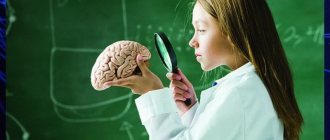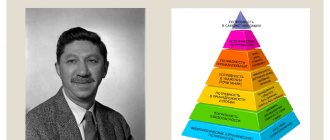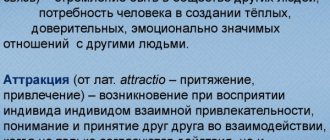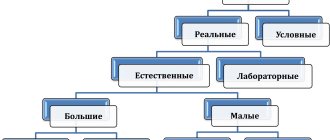The concept of activity in psychology
From the point of view of psychology, “personal activity” (from the Latin activus - active) is a person’s active attitude to the world, a person’s ability to make socially significant transformations of the material and spiritual environment based on the development of the socio-historical experience of mankind; manifests itself in creative activity, volitional acts and communication.
Evolutionarily, the simplest form of activity (sensory) is the almost mechanical implementation of an internal program or a reaction to a change (impact) in the external environment (tropism, taxi, reflex). This form of activity is characteristic of unicellular and multicellular organisms. A more complex form (perception) is instincts. Instinct is a set of innate tendencies and drives that play a motivating role in the emergence of behavior. This form of activity is found in insects and protozoa. There are also studied forms of activity that are realized through skills, where a skill is an action that is formed through repetition and brought to automation. Creative (intellectual) activity also plays an important role in life, using thinking to build targeted programs for each new action. This form of activity is characteristic of mammals and primates. Finally, reflection (conscious activity) occurs as a form of activity. Reflection is the subject’s appeal to himself, to his own personality (values, interests, motives, emotions, actions), to his knowledge or to his own state. This type of activity is found only in humans.
Mental activity, from its material carrier, is the activity of the brain, equipped with organs for perceiving information, executive and energy structures. The essence of this activity is the processing of information, its evaluation and use to control various types of movements, including speech ones.
Human activity consists of information and energy metabolism (exchange) with the external environment. There are seven types of this interaction: behavior, consumption, play, learning, activity, communication and contemplation.
Behavior - here activity manifests itself as the ability of animals, including humans, to change their actions under the influence of internal (homeostasis) and external (adaptation) factors. Behavior can be: searching and feeding (saturation and accumulation of food), comfortable, reproductive (polygamy, monogamy or polygamy), parental, defensive, aggressive, social, territorial, exploratory.
Consumption is an activity that involves the direct satisfaction of needs, when a need is considered an internal state of a psychological or functional feeling of the absence of something (need).
A game is a type of unproductive activity in which actions are limited by rules and aimed at creating, developing and maintaining a process within given limits. Higher animals have a clearly defined juvenile phase in which they exhibit play behavior. The nature of play in animals is determined by species specificity and strongly depends on the lifestyle, since elements of the behavioral repertoire of an adult—certain forms of feeding, mating, social and nest-forming behavior—are manifested (and improved) in play. For children, games are preparation for further activities. Through play, a child learns new roles, develops skills and expands life experience.
Training is a type of activity in which the quantity and quality of elements of knowledge and skills of the learner are brought to an appropriate level, which is the purpose of training.
Activity is an object-oriented form of activity that involves the transformation of elements of the environment and creates the conditions necessary for life.
Communication is an interpersonal form of activity, the process of establishing and developing contacts between living organisms arising from the needs of joint activity, including the exchange of information, mutual awareness and attempts to influence each other.
Contemplation is a sensory stage of cognitive activity. From a Marxist point of view, knowledge is not passive contemplation, but active activity, inseparable from the transformation of the world.
All forms of activity usually have internal (spiritual) and external (behavioral, practical) components.
Note to parents: how to do this
An active person means active, energetic. Children become like this in families that support a democratic style of relations between them and adults. It presupposes flexibility in relationships: by showing sufficient demands and control, parents respect the child’s opinion and position, develop his independence, initiative, and self-criticism. Possible instructions and meaningful encouragement stimulate increased activity in achieving the goal. What is important is sufficient help, a calm, business-like analysis of both the results of the child’s initiative, as well as mistakes made and successful actions.
An authoritarian parenting style suppresses a child’s activity, since threats of punishment and coercion cause fear of violating an adult’s instructions and making mistakes in their actions.
The liberal style, on the contrary, is undemanding towards children. Maximum freedom with a minimum of restrictions on behavior creates aggressiveness and permissiveness. Such children believe that achieving a goal consists of forcing adults to bring them what they want on a platter, and not in showing intelligence and enterprise themselves.
Forms and patterns of activity
Mental activity (psyche) is divided according to content into cognitive, emotional and volitional; from the point of view of consciousness - conscious and unconscious; from the point of view of personality - personal and impersonal. This type of activity can also be called internal activity, i.e. activities that occur within one reality.
Behavior is associated with an attempt to build a holistic picture of the personality and its basic mental processes, as well as with the study of individual differences. This type of activity can also be called external activity, i.e. activity between two realities. The result is four models of activity that highlight the different relationships between the two realities:
- Passivity is when one reality influences another, and the internal state of the second reality and its reaction to external influence are equal to 0 (zero). This model does not occur in life.
- Reactivity is when one reality affects another, the internal state of which is 0 (zero), but at the same time there is a reaction from it corresponding to the external influence. This model is found in behaviorism.
- Self-activity - one reality influences another, the reaction of which is equal to its internal (own) state. This model is found in Freudianism and the humanistic school.
- Conditioned activity - one reality influences another, the reaction of which is a function of a combination of external influence and internal state (personal experience). This model is found in neo-Freudianism and in the everyday active approach.
To learn more about various approaches to studying the source of personality activity, we turn to the history of its development.
The question of personality activity was first raised by the Austrian psychiatrist S. Freud, the founder of the theory and practice of psychoanalysis. The main provisions of this theory substantiate the opinion that the source of human activity is the instinctive drives that he has from birth and which are inherited. This is a world of instincts, biological and physiological traits, unconscious impulses, the nature of which is “unknown.” What is striking in his teachings is the recognition of the priority of the biological in man. A positive point in Freud's teachings can be considered his appeal to the realm of the unconscious in the human psyche, which significantly affects his life activity. Neo-Freudians, guided by Freud's basic postulates about the unconscious, in the study of the human psyche went in the direction of limiting sexual characteristics and searching for new driving forces of human behavior. Neo-Freudianism begins with the recognition of the decisive role of the environment and social mechanisms. Unfulfilled sexual traits are replaced in the subconscious by the desire for power, resulting from the consciousness of one’s own inferiority (C. Jung, A. Adler), the desire for security or satisfaction of one’s own desires (K. Horney), the inability to come into harmony with the social structure of society and the resulting this feeling of loneliness (E. Fromm), etc.
Later, other schools developed their own theories of personality, in particular the humanistic school, which rejected the neo-Freudian position that natural impulses are necessarily hostile to society (fear of loneliness, aggression, the desire for power or the gratification of desires). On the contrary, they proposed to consider innate altruistic motives as a source of activity (K. Rogers). Other representatives of the same school developed their own concepts, the so-called “needs theory” (G. Allport), according to which people differ in the number and degree of expression of certain independent traits, and a description of personality can be obtained by testing or other less thorough study of them, and the “theory needs” (A. Maslow), according to which seven classes of needs appear from birth and gradually accompany human development. Physiological (organic) needs, safety needs, belongingness and love needs, respect (reverence) needs, cognitive needs, aesthetic needs, self-realization needs. Moreover, according to the author, physiological needs lie at the base of this pyramid of motivation, and higher needs, such as aesthetic and self-actualization, form its apex.
Individual style of activity
This is an adaptation of the human nervous system and body characteristics to the activity being performed. The basis of individual style is:
- human temperament;
- skills;
- skills;
- experience.
The purpose of such a device is to achieve the best result at the lowest cost. Temperament determines the success and failure of a person in a specific activity.
Problems of personality activity
Finally, boarding school psychology also approaches the development of the problem of personal activity. In Russia, the science of behavior begins with the works of I.M. Sechenova, I.P. Pavlova, A.A. Ukhtomsky, V.M. Bekhterev, who came up with the idea of an active relationship between the organism and the environment. It should be emphasized that Pavlov’s teaching on conditioned reflexes had a significant influence on the research of many foreign physiologists and psychologists dealing with problems of behavior and activity of animals and humans.
Psychological problems of human activity were solved by many Russian psychologists of different periods. Central to this concept is the concept of activity. S.L. Rubinstein formulated the principle of the unity of consciousness and activity. Attitude theory D.N. Uznadze, based on consideration of the development of the subject’s attitude, analyzes the patterns of mental activity. ON THE. Bernstein, P.K. Anokhin, A.R. Luria and other scientists are devoted to the problem of the psychophysiological nature of activity. The greatest attention to the social nature of activity is paid in the works of B.F. Lomova, K.A. Abulkhanov-Slavskoy, E.V. Shorokhova. Bozovic showed how, in the complex dynamics of interaction between activity and interpersonal communication, a child at different periods of his life forms a certain view of the world, which is called an internal position. As in the case with it, the most important internal feature of activity in Leontiev’s concept is the motivational sphere of the individual. Another important concept in his theory is personal meaning. It expresses the connection between the goals of human activity, i.e. what he directly strives for at the moment, with his motives, i.e. with what motivates him. The wider and more varied the activity in which a person participates, the more developed and ordered it is, the richer he himself is.
The motivating factor for activity is “goal”. A goal is a perceived result towards which an action (activity) is currently directed, associated with an activity that satisfies an actualized need.
A need is a need that manifests itself in a person’s dependence on certain conditions necessary for life and activity. Needs always reflect stable life dependencies of the organism and the environment. Human needs develop along with the development of social living conditions, production, and scientific and technological progress. The very process of satisfying needs contributes to its development and the reproduction of new needs, which are inevitably generated by various spheres of people's social life and their activities. The higher the level of civilization of a society, economic and spiritual development, the richer and more diverse its needs. The main characteristics of human needs are strength, frequency, occurrence and method of satisfaction.
Internal motives for actions become motives that arise as a result of awareness of human needs and are manifested in specific efforts to satisfy them. Motive is a real motivation that encourages a person to act in a specific life situation and under certain conditions.
In the process of growing up, many guiding behavioral motives ultimately become so characteristic of a person that they become his personal qualities. These include motivation to achieve a goal or the desire to avoid failure, the motive of power, the motive of helping others (altruism), aggressive behavioral motives and others. Dominant motives become one of the main characteristics of a person, which is reflected in the manifestations of other personal qualities.
Does society need active people?
You might be interested in: Development of a truncated cone. Area formula and example of solving the problem
Stimulating employee business entrepreneurship is one of the goals of modern management. Its development leads to a significant increase in labor productivity and the development of a culture of industrial and non-productive relations.
In psychology, activity is defined as the activity of an individual aimed at the environment in order to satisfy his own needs. Its owner is considered to be a person with such personal qualities as:
- focus,
- awareness of the choice of ways and means to achieve goals,
- the ability to analyze the results of one’s actions and adjust them taking into account the current situation.
Such an individual, satisfying his own material, social, ethical, artistic needs, strives to transform the environment, meaningfully improves tools, and participates in solving creative labor and social problems. His personality improves because he wants to know more, learn a lot. That is, it can be argued with good reason that the initiative of members of society contributes to its comprehensive progress.
Forms of activity orientation and what determines them
A set of stable motives that orient a person’s activity (activity) and are relatively independent of the current situation is usually called orientation in the scientific literature. It should be noted that a person’s orientation to action is always socially conditioned and formed in the process of education.
The most primitive, essentially biological form of orientation is attraction. From a psychological point of view, an attraction is a mental state that expresses an undifferentiated, unconscious or insufficiently conscious need. Usually attraction is a temporary phenomenon, since the need for it either disappears or is realized and turns into desire.
Desire is a conscious need and attraction for something very specific. It should be noted that desire, when it is sufficiently conscious, has stimulating power. It increases awareness of the purpose of future actions and the development of your plan. This form of focus is characterized by awareness not only of one’s need, but also of ways to satisfy it.
The next form of directionality is aspiration. Aspiration occurs when a volitional component is included in the structure of desire. Therefore, aspiration is often considered a very specific drive for activity.
A person's orientation is best seen in his interests. Interest is a specific form of manifestation of a cognitive need that provides a person’s orientation in understanding the goals of an activity, thereby contributing to a person’s orientation in the surrounding reality. Subjectively, interest lies in the emotional mood that accompanies the process of learning or attention to a specific subject. One of the most important properties of interest is that when satisfied, it does not disappear, but, on the contrary, gives rise to new interests that correspond to a higher level of cognitive activity.
Interests are the main driving force for studying reality. A distinction is made between direct interest due to the attractiveness of the object, and indirect interest in the object as a means of achieving the goals of the activity. An indirect feature of the consciousness of need, reflected in interests, is the stability of interests, expressed in the duration of their maintenance and in their intensity. It should also be emphasized that the breadth and content of interests can serve as one of the distinctive features of personal activity.
Interest in the dynamics of its development can turn into a tilt. This occurs when the volitional component is included in the percentage. Inclination characterizes an individual's orientation toward a particular activity. Addiction is based on a person’s deep and persistent need for a particular activity, that is, interest in a certain type of activity. The basis for leaning may also be a desire to improve skills related to this need. It is believed that a developed aptitude can be considered a necessary condition for the development of certain skills.
The next form of manifestation of personal orientation of action is the ideal. An ideal is the objective goal of a person’s inclination, that is, what he strives for, what he focuses on, and is concretized in an image or representation. People's ideals are formed under the influence of social living conditions, in the process of education and upbringing. Human ideals can act as one of the most important features of a person’s worldview, that is, his system of views on the objective world, on man’s place in it, on man’s relationship to the surrounding reality and to himself. Worldview reflects not only ideals, but also the value orientations of people, their principles of knowledge and action, their beliefs.
Faith, the highest form of orientation, is a system of motives that motivates a person to act in accordance with his views, principles and worldview. The basis of beliefs is knowledge that is true for a person, indisputable, in which he does not doubt. The peculiarity of beliefs is that their knowledge is presented in unity with feelings and covers the entire personality. Conviction is where there is suffering and pangs of conscience, when principles are violated in actions and deeds. A person's conviction can manifest itself in various areas of his life and activity and can be divided into moral, intellectual, aesthetic, etc., depending on the circumstances.
Beliefs become a powerful driving force when the actions driven by those beliefs become habits. K. Ushinsky called the moral capital that a person invests in his nervous system a good habit. The capital of habit grows out of use and gives a person the opportunity to use his precious power, the power of conscious will, more and more fruitfully, without wasting his consciousness and will to fight against difficulties already overcome.
What did ancient philosophers say about her?
Scientists of the ancient East and West approached the study of what human activity is from both materialistic and idealistic points of view.
Socrates (470-399 BC, Ancient Greece) explained it by the state of the soul, which he considered its mental property, the focus of moral ideas. These ideas are formed as a result of a person’s learning what is good and evil, and the types of activity and the nature of his actions depend precisely on this knowledge. Socrates' slogan “know thyself” should be understood as a call to analyze behavior and attitudes towards it, and not to analyze one’s own emotions and experiences.
Aristotle (384-322 BC), studying what mental activity is, called exercise in moral actions as a condition for its increase. Simple knowledge of good and evil does not make a person the owner of such qualities as, for example, virtue and prudence - constant training and exercise in them make him such.
The teaching of the Stoics arose in Athens in the 4th century BC. e. His followers believed that increasing the activity of the psyche is inaccessible to ordinary people, its guidance is the lot of only true sages, whose mind is dispassionate and does not allow emotional experiences. Any emotional upheaval deprives a person of internal freedom and interferes with the fulfillment of his duty.
Epicurus (341-270 BC, Ancient Greece), on the contrary, considered renunciation of social activity to be true happiness. He saw it in the satisfaction of simple needs. The will, mind, and mental activity of a person must be directed to training in self-restraint from unattainable pleasures, otherwise suffering from their unattainability is inevitable.









